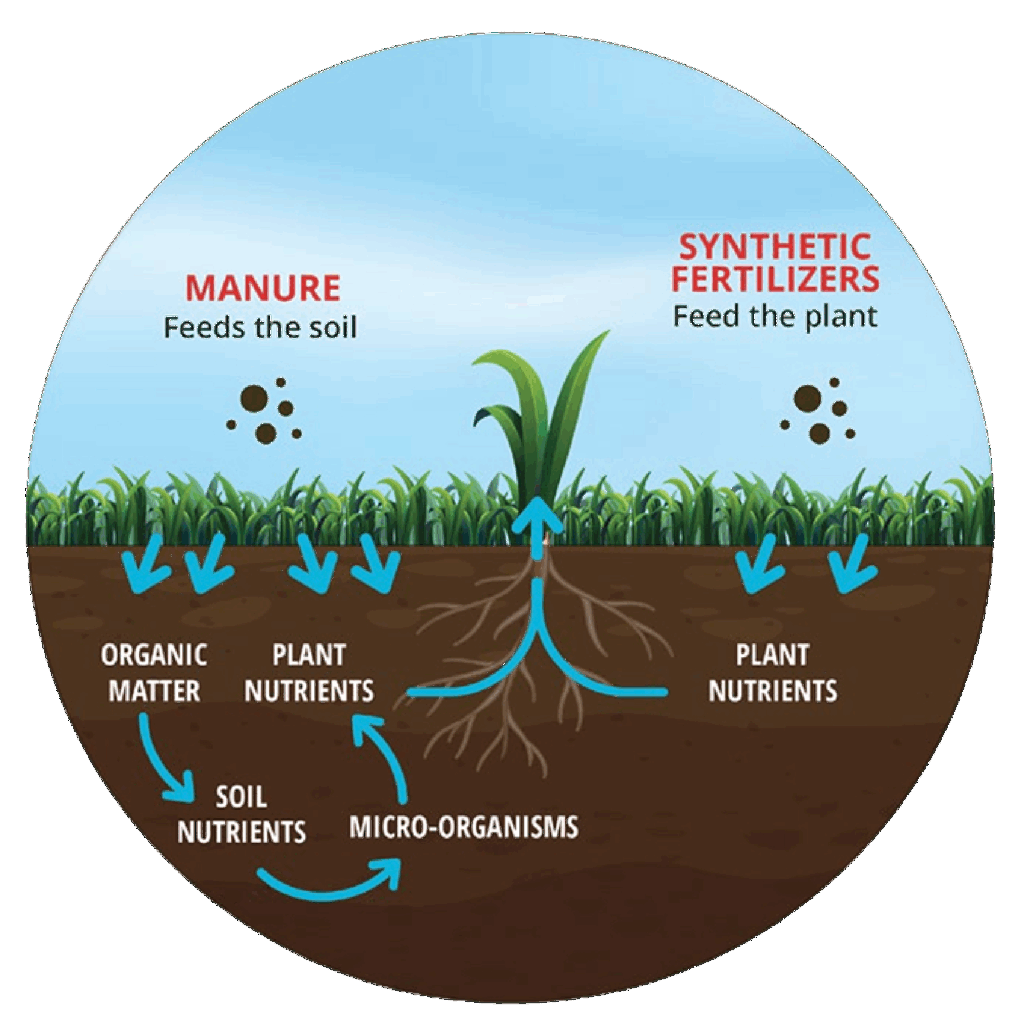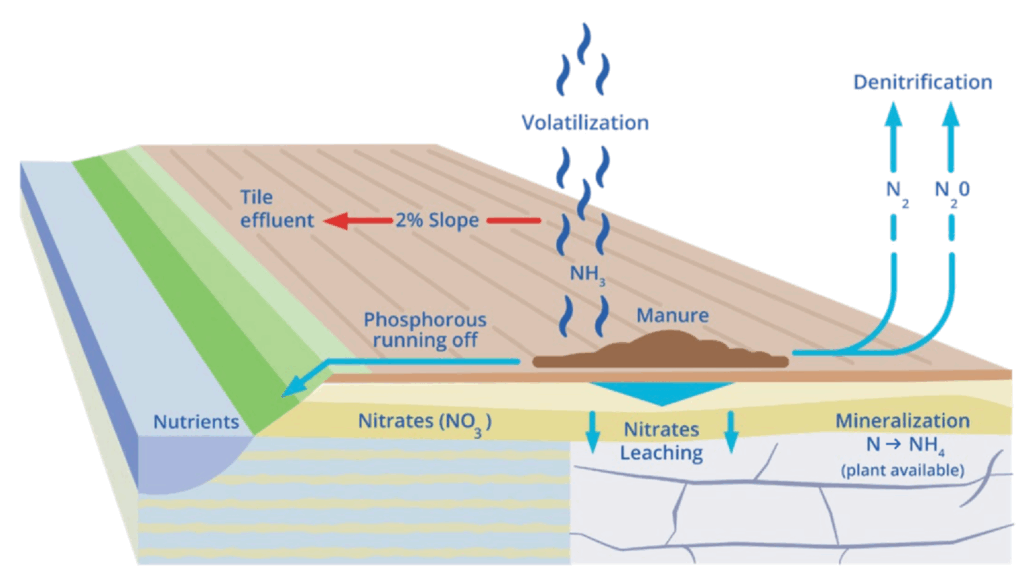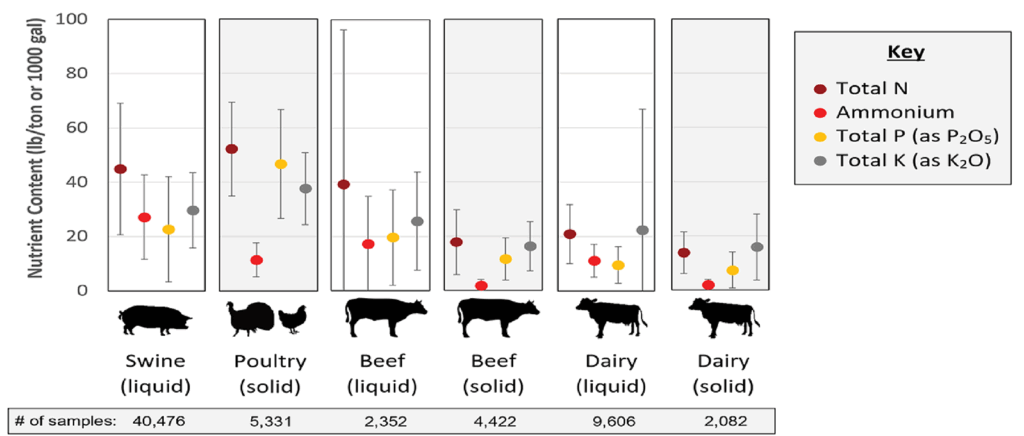Improving Nitrogen Management in Atlantic Canada
Reducing Nitrogen Losses from Manure
David Burton, Dalhousie University
Martin Chantigny, Agriculture and Agri-Food Canada
Manure is a vital resource in agriculture, providing essential nutrients for crop growth and contributing to soil health. However, inefficient manure management can lead to significant environmental challenges, including nitrogen (N) losses to the atmosphere as nitrous oxide (N20; a potent greenhouse gas) and to water bodies through nitrate (N03-) leaching. In the diverse climatic and soil conditions of Atlantic Canada, optimizing manure management practices is key to improving farm productivity, sustainability and environmental stewardship.

Primary Nitrogen Loss Pathways Associated with Manure Management Ammonia Volatilization: Liquid manure is often alkaline (high pH) and contains high amounts of ammonia (NH3). As a result, there is a high potential for loss of NH3 to the atmosphere during handling, storage and field application. Exposure to the atmosphere should be minimized at all stages to reduce these losses. If it cannot be directly injected, manure should be placed close to the soil surface and incorporated into the soil as soon as possible after land application.
Denitrification: Under wet conditions, microorganisms can convert N03– to N20 and N2 (a major component of air). The extent to which N20 is the product of denitrification depends upon several factors, including the degree to which N03– is allowed to accumulate, the aeration of the manure pile and the availability of organic carbon compounds to fuel microbial activity.
Nitrate Leaching: The application of excessive amounts of manure can lead to N03– accumulation in the soil which, during periods of high rainfall, can result in the leaching of the N03– to groundwater or runoff to surface water.
Strategies for Improved Manure Management
There are numerous practices that can be used to reduce N losses and increase N retention in manure, ranging from the handling in the barn and during land application to manure storage.
In-Barn Manure Management:
- There is the potential for loss of NH3 and odours associated with the accumulation of feces and urine on the barn floor. Urine that accumulates on the barn floor allows for urea hydrolysis to form alkalinity and NH3, resulting in high amounts of NH3 loss to the atmosphere. The rapid removal of manure from the barn floor by scraping, washing or the use of slatted floors speeds the transfer to storage where the material is diluted and exposure to the atmosphere is reduced.
- The addition of carbon-rich bedding materials in the barn, such as straw or wood chips, can also reduce NH3 loss by immobilizing the N as organic N that has a low potential for loss. The addition of carbon may result in increased rates of denitrification, resulting in higher losses of N20.
Manure Storage and Handling:
- The separation of manure solids from the liquid fraction has been shown to reduce methane emissions but may result in increased N20 and NH3 emissions, depending on how the solid fraction is managed.
- Acidification of manure storages with sulfuric acid (H2SO4) limits the activity of methanogens, the bacteria that produce methane. Acidification also reduces NH3 emissions. Low dose acidification (reducing pH to 6.5) of manure remaining in the pit after it has been emptied has been shown to be effective in reducing CH4 and NH3 emissions.
- The use of synthetic manure storage covers reduces contact with the atmosphere and therefore reduces NH3 and CH4 emissions. Impermeable synthetic covers have been shown to reduce N20 and CH4 emissions. Covers made from natural materials (straw, wood chips) can also result in reduced NH3 and result in increased N20 emissions.
- Composting and passive aeration can result in reduced CH4 and N20 emissions from solid storages and, depending on the degree of aeration maintained in the compost, may result in increased NH3 emissions.
Land Application of Manure:
There is the potential for the loss of NH3 during the land application of manure. In general, minimizing the exposure of the manure to the atmosphere will reduce these losses.
- Exposure to the atmosphere can be minimized by applying liquid manures close to the soil surface or injecting the manure directly into the soil.
- For solid manures, the rapid (< 1 day) incorporation of manure into the soil reduces NH3 losses.
There is the potential to produce N20 following land application of manure. The ammonium (NH4+) contained in the manure is transformed to N03– following land application by the processes of nitrification, resulting in N20 emissions. The accumulation of N03– in the soil can also result in N20 emissions as a result of denitrification, particularly in conditions where there is increased microbial activity associated with the addition of the carbon substrates contained in the manure. These emissions can be managed by delaying the process of nitrification.
- Nitrification inhibitors can be added to manure, particularly liquid manures, to delay the conversion of NH4+ to N03-. This inhibition occurs over several weeks and can be used to better synchronize N03– production with plant N demand. See fact sheet on Improved Nitrogen Management.
- For the application of manure in the fall, delaying manure application until the soil has cooled to 5C will result in a slowing of the nitrification process and ensure that N remains in the NH4+ over the winter period, which is the period of greatest potential for N03– loss as result of either denitrification or N03– leaching.
How to Effectively Use the Nitrogen Contained in Manure
Producers often undervalue manure N due to uncertainty as to how much N will become available and when it will become available. Here are a few general rules to help you quantify the availability of N in your manure:
- First step is to get a manure test. While there are tables to estimate manure nutrient content, nothing beats an actual test.
- For liquid manure, particularly swine manure, much (50 to 80 per cent) of the N is in the form of NH4+. This form of N has the greatest potential for loss as NH3 but is also immediately plant-available. You should credit this N as if it were fertilizer N.
- For solid manure the situation is a bit more difficult. Because of the carbon-rich bedding added, much of N is in the form of organic N. This form of N is less likely to be lost, but it is also more slowly plant available.
- The New Brunswick Soil and Crop Improvement Association website contains fact sheets for general N recommendations for various crops that contain a section that will help you calculate N credits associated with manure application.

Figure 1: Loss pathways from the land application of manure (from PEIDAL, 2024)

Figure 2: University of Minnesota Extension, Fact Sheet. Reviewed 2021. (Based on samples collected in Minnesota 2012-2018; reported as pounds of nutrient per 1,000 gallons of manure (liquid) and pounds of nutrient per ton of manure. (solid)).
Key Messages
Manure is an important N resource.
Making the most of the N value in manure requires reducing N losses.
Ammonia losses can be reduced by avoiding the accumulation of NH3. This can be done by dilution, acidification or immobilization as organic N.
The loss of N03– via denitrification or nitrate leaching can be minimized by avoiding excessive rates of land application of manure.
Credit the N content of your manure. The amount and timing of N availability can be estimated and should be included in your crop N balance calculations.

Living Lab New Brunswick uses a unique approach to agricultural innovation in Canada, bringing together farmers, scientists and other partners to co-develop and test innovative farming practices in real-world conditions. It is part of a nationwide network of living labs under the Agricultural Climate Solutions – Living Labs program, funded and supported by Agriculture and Agri-Food Canada. Each project aims to accelerate the development and adoption of sustainable on-farm solutions to address climate change.
